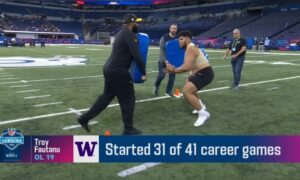I know we’re all still trying to process today’s news of Heath Miller’s retirement. I’m still freaking out so it’s perfectly ok if you are, too. And though there is much to talk about what he meant to the team, this is a business, and like any business, you keep moving forward and plan the next step.
You’ll never find someone quite like Miller. But even coming close will be a difficult chore. The Pittsburgh Steelers have never, maybe will never, swoon over the big, athletic, “move” tight ends that litter the NFL. Pittsburgh, perhaps more than any other team in the league, demands their tight ends to be as versatile and with as diverse a skillset as possible.
Block defensive ends in the run game, either by yourself or in combination, working to the second level. Block defensive ends and outside linebackers – by yourself – in pass protection. Oh yeah, and catch a little bit. That doesn’t happen in college. It’s about the spread, winning in space, and making big impact plays to put on a highlight reel.
As Kevin Colbert talked about with the media, a college tight end that fits the Pittsburgh Steelers’ scheme is rare, the quote courtesy of Will Graves at The Associated Press.
“Tight ends and fullbacks are really like dinosaurs, they’re harder to find. There just aren’t a lot of conventional tight ends. And some of the guys who are called tight ends on the spread-option teams are actually big guys playing in the slot and they’re really more for blocking on the perimeter, passes or runs, than they are being a traditional tight end.”
My mind immediately jumps to the small bit of praise Todd Haley dished out to Cameron Clear, the big-bodied UDFA from this past season, and why Haley thought he had a chance to succeed in the offense.
“I think in college you’re seeing a lot of the spread, but at the same time I think there’s enough teams like us that still value a tight end like Heath [Miller] or Matt Spaeth that can block and be an integral part of what you’re doing….I think that as long as we’re all here, we’ll value a big tight end that catch and block.”
Of course, Clear quickly flamed out but it illustrates a larger, worst-kept secret. Pittsburgh has a unique way of evaluating tight ends and it is in conflict with the general trend of the college and pro game.
It leaves only a handful of even intriguing options in each draft. Expect Hunter Henry to get a lot of publicity now. But he’s an unlikely first rounder and probably won’t make it to the Steelers’ second round pick, putting the team in a Maxx Williams-type situation. And they won’t have the ammunition to trade up, or if they do, will deplete their picks next year, too.
Ohio State’s Nick Vannett makes sense, largely for his school. You know the Steelers love Buckeyes and Vannett was an under utilized receiver who can block. In the later rounds, keep an eye on the name David Morgan. He’s from smaller school, UTSA, and though I haven’t personally watched him yet, I’ve heard good things about him as a blocker. The Steelers typically prefer their tight ends to come from well-known places but they did invest a 7th in Rob Blanchflower two years ago.
In free agency, Dwayne Allen would surely be a splashy signing, and I’ve always been a big fan of his well-rounded game. Maybe he’s too rich for the Steelers but he sure would look good in Pittsburgh, and every report has the Indianapolis Colts intending to sign Coby Fleener, not Allen.
The other option, and this is a little more out of the box, is to infuse the offense with more 10 (1 RB, 0 TE) personnel. That would allow Sammie Coates a pathway to see consistent playing time, putting your most explosive pieces on the field. Le’Veon Bell, Antonio Brown, Markus Wheaton, Martavis Bryant, and Coates, spread out, forcing a defenders onto islands and trying to cover some top-tier talent. This isn’t a video game, and there consequences to that, but man, does that lineup look pretty.
I’m sure the team had some advanced notice of Miller’s decision, giving them more time to develop a plan. But it doesn’t make that journey any easier, given their limited options.








